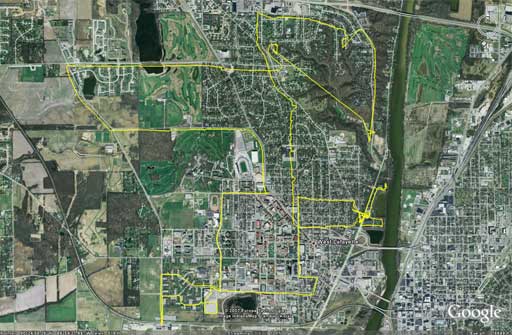I am a huge fan of my Delorme Tripmate. It’s a cheap serial GPS receiver that it is very easy to work with and interface with my microcontroller projects. It was introduced over 10 years ago and mine is still in great condition. I’ve used it for a number of projects (e.g., PIC16F88 Delorme Tripmate GPS Logger, GPS Logger with Time and Speed, and a modified version for GPRMC) and I plan on creating more. However, it’s starting to show its age and I have found that over time I’ve become less and less fond of its chipset. The biggest problem has been the gross inaccuracies in reported position.
These days, it is not uncommon to have high horizontal and vertical (altitude) accuracy with the SIRF III chipset. And with the advent of WAAS, most chipsets are able to easily pinpoint the location within 10 meters. For example, here are the reported accuracies for a number of newer GPS units:
- Garmin eTrex – SPS: <15 m
- Garmin GPS 16 – SPS: <15 m, USCG/RTCM: 3-5 m, WAAS: <3 m
- Garmin GPS 10 – SPS: <15 m, WAAS: <3 m
- Garmin GPS 18 – SPS: <15 m, WAAS: <3 m
- Magellin eXplorist series – SPS: <7 m, WAAS/EGNOS: 3 – 5 m (note that most are USB, not serial)
Other individuals have investigated GPS accuracy, notably David Wilson with his great GPS Accuracy page, but unfortunately the Delorme Tripmate is old enough where it is difficult to find opjective information about its accuracy and error rate. However, in 1997, John McCormick at GCN found that “At some points during [a test] drive, the indicated location was off by as much as 50 feet, but at any location I found that I could stop and reset my position, and the accuracy would go back to plus or minus 10 feet.D oing exactly the same test on another day, I found that Tripmate’s accuracy had degraded to plus or minus 150 feet.”
Unfortunately I’ve also found that the accuracy for my Tripmate drastically decreases when it loses its fix. For example:
I rode my bike on the road for the vast majority of this trip, but the positions are often off by up to 60 (!) meters. What can I do? The most effective method of ensuring a high quality 3D fix with the Tripmate is to ensure that it has an unobstructed view of the sky. While this is usually not a problem when I am driving, it is an issue when I run and bike. I might be able to use an amplified antenna; however, I would have to remove/bypass the internal antenna to ensure a high quality signal. It seems as though I might be stuck with the problems.
Or I can buy a new GPS receiver.
